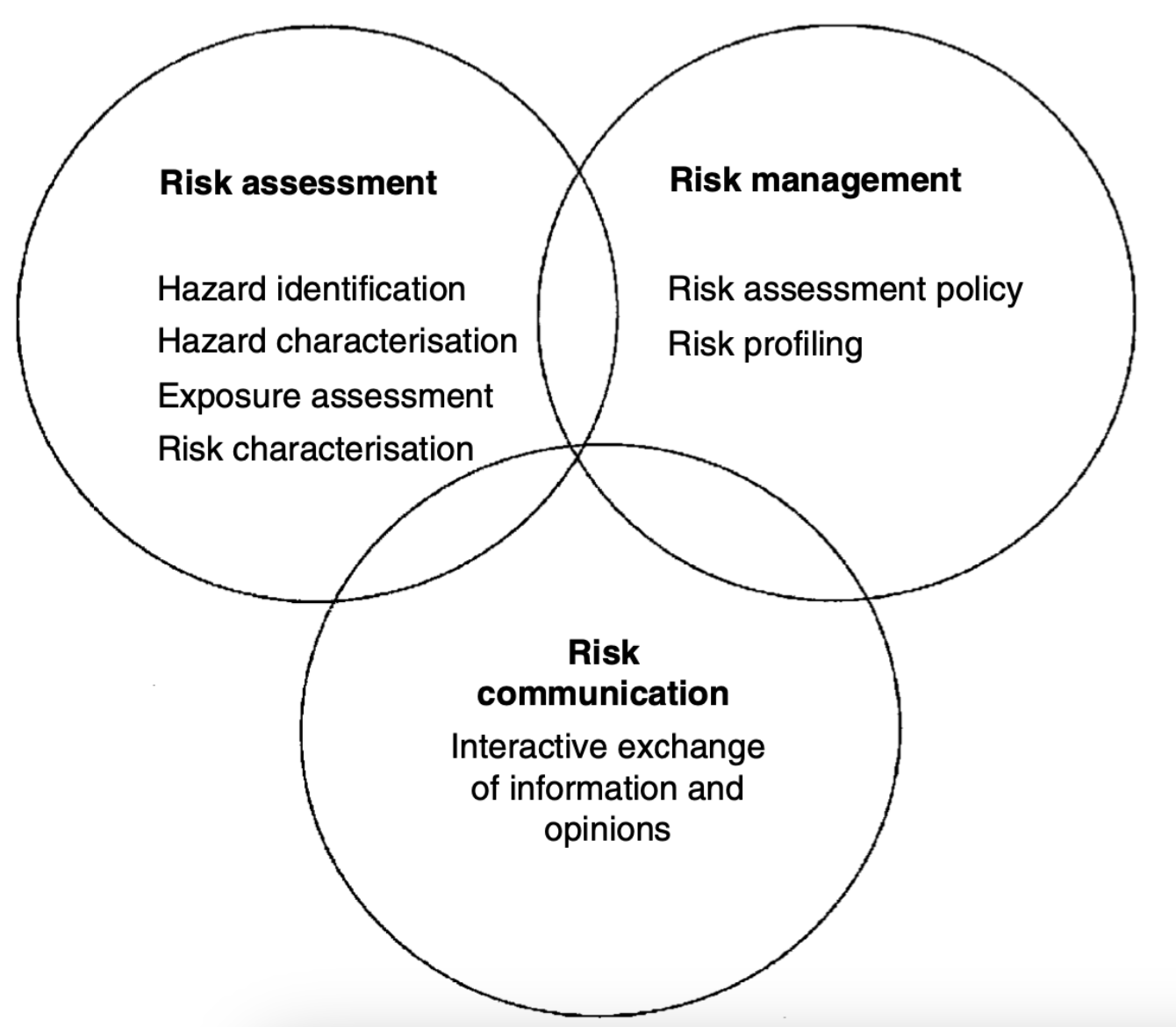FMLec | M5: High-temperature food preservation method
1/48
There's no tags or description
Looks like no tags are added yet.
Name | Mastery | Learn | Test | Matching | Spaced |
|---|
No study sessions yet.
49 Terms
_ is a traditional fpm involving use of any and all temperature above ambient ( > 10-15C)
Application in preservation is based on destructive effects of heat on microorganism
2 common methods: pasteurization (reduce microbes to safe levels), sterilization (complete elimination)
High-temperature fpm
Enumerate 2 most common methods of high-temp food preservation
Pasteurization
Sterilization
Enumerate 7 factors affecting microbial heat resistance
wfsp nit
Water
Fats, carbohydrates, proteins
Salts
pH
Number & age of organism
Inhibitory compounds
Time & temperature
T/F: In general, increase in water activity leads to decreased heat resistance
TRUE
Bc presence of water allows it to conduct heat
T/F: Temperature and time are inversely correlated to killing effect of heat
FALSE
Temperature and time are directly correlated to killing effect of heat
Relative heat resistance of microorganisms is related to _, e.g., yeast & molds are sensitive to heat (grow best ambient temperature); psychrophiles vs. mesophiles vs. thermophiles
optimal growth temperatures
Explain how water affects microbial heat resistance
Presence of water allows faster protein denaturation
Dried vs. Moist cells; dried more resistant because water are absorptive of heat & thus moist feel its effects more
Increased heat resistance lhwm
Low humidity
Low water activity
Low moisture
Explain how fats, carbohydrates, & proteins affects microbial heat resistance
Fats generally increase heat resistance of some microorganisms, e.g., long-chain FAs > short-chain FAs
Carbohydrates increase heat resistance partly due to decrease in water activity
Proteins increase heat resistance bc they have protective effects on microorganisms
Explain how salts affects microbial heat resistance
Some salts (Ca2+) decrease water activity and thus have protective effect on microbes by increasing heat resistance
Some salts, however, phosphates increase water activity and thus tend to make some microbes heat-sensitive
Explain how pH affects microbial heat resistance
Microorganisms have higher heat resistance at their optimum pH (point of comparison is the same microbe)
Thus, less heat is applied to sterilize acidic food (bc they’re already at a non-optimal pH; lower heat tolerance)
Explain how number & age of organism affects microbial heat resistance
Number
High cell density > low cell density since they would produce also more heat-protective substances compared to low cell
Age
Old cells (stationary) vs. Actively growing cells (log)
Stress response activation
Higher Aw on actively growing cells; lower heat resistance
Lag phase vs. log phase cells
Stress response activation
Higher Aw on actively growing cells; lower heat resistance
Old bacterial spores vs. Young bacterial spores
More endospores formed in older culture > younger culture
More mature protective layers and relatively lower water content
Explain how inhibitory compounds affects microbial heat resistance
Decreased heat resistance because the cells are not in their optimal condition and are affected by stress, thus less effective at resisting heat
Explain how time & temperature affects microbial heat resistance
Time & temperature are both directly correlated to killing effect of heat
Higher temp > more effective killing by heat
Longer time > more effective killing by heat
Relative heat resistance of microorganisms are related to their optimal growth temperatures
e.g., Yeasts & molds are sensitive to heat bc they grow optimally at ambient temp
Psychrophiles (most sensitive) vs. Mesophiles (most resistance) vs. Thermophiles
Enumerate and explain 6 thermal destruction parameters of microorganisms
tt dzf 12d
Thermal death time
Time needed to kill a given no. of microorganisms at a specified temperature
Thermal death point
Temperature needed to kill a given no. of microorganisms at a fixed time (usually 10 mins)
D value
Time needed to destroy 90% of organisms
Z value
Temperature needed to
increase death rate by 10-fold
decrease D value by 10-fold
Kill more in shorter amount of time
F value
Time at a given temperature needed to destroy spores or vegetative cells of a particular organism
12-D concept
Food safety standard that uses heat to reduce no. of C. botulinum spores in canned food by 1012 times, ensuring almost complete sterility
D = D value, time needed to kill 90% of spores
12 of those steps = 99.9999999999% killed
Goal = u want a 12 log reduction of C. bot spores
_ is the time needed to kill a given no. of microorganisms at a specified temperature
Changing of either of 2 factors will change time
Decontam 121 C by 15 mins
If temp increased to 140, time would be shorter
Thermal death time
_ is the temperature needed to kill given no. of microorganisms at fixed time (usually 10 mins)
e.g., 100 C for 10³ cells 10 mins exposure
Increasing no. of cells = increase temp
Thermal death point
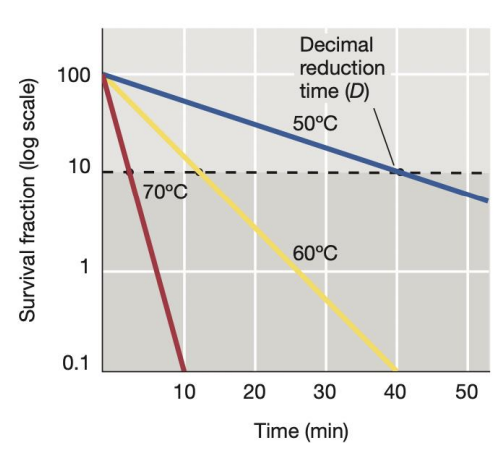
_ is the time needed to destroy 90% of microorganisms
In figure shown, what is the time needed to destroy organisms by 90%?
If temp is increased from 50 → 60, time = ?
70?
D value (decimal reduction time)
40 mins
12 mins
4 mins
_ is time needed for survivor curve to traverse 1 log cycle
D value (decimal reduction time)
100 → 10 = 1 log cycle
10 → 1 = 1 log cycle
1 → 0.1 = 1 log cycle
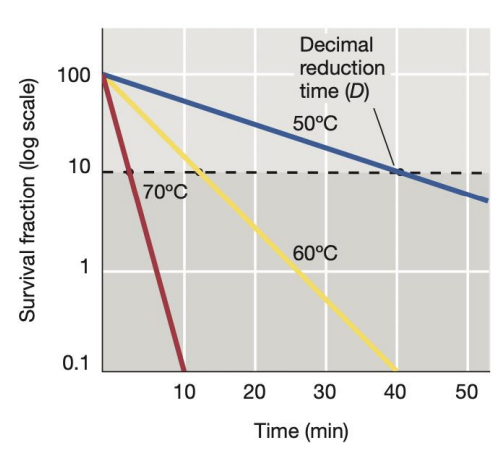
_ is the temperature needed to increase death rate by 10-fold, decrease D value by 10-fold
D value in log (y) vs. Temp (x)
At 220 F, D value = 113 mins (time needed to kill 90% microbes)
At 237.5 F, D value = 11.3 mins
Allows for calculation of equivalent heat processes at diff temps
z Value
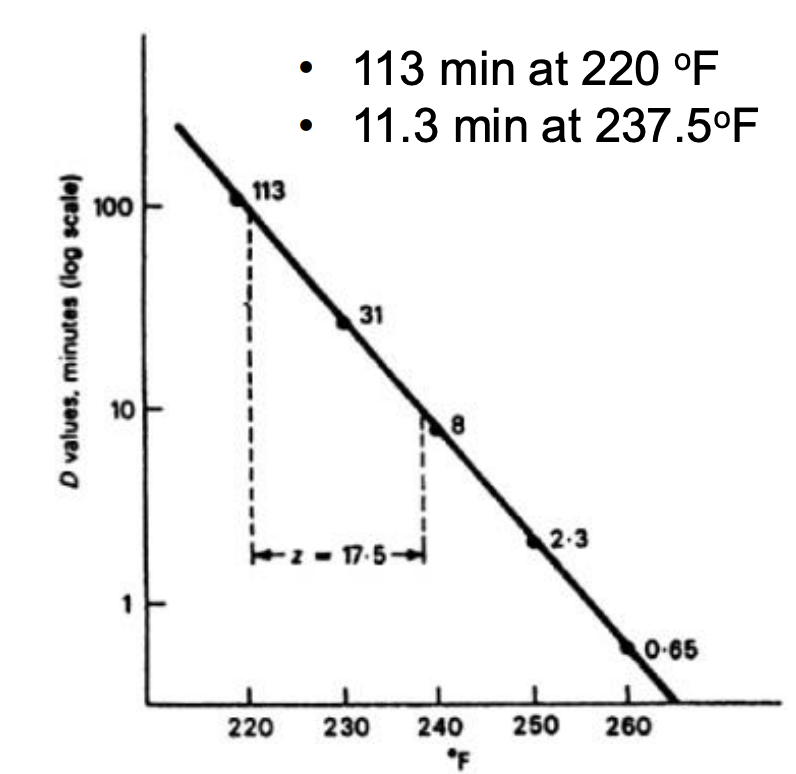
_ is the difference between temperature of 2 D values
z values
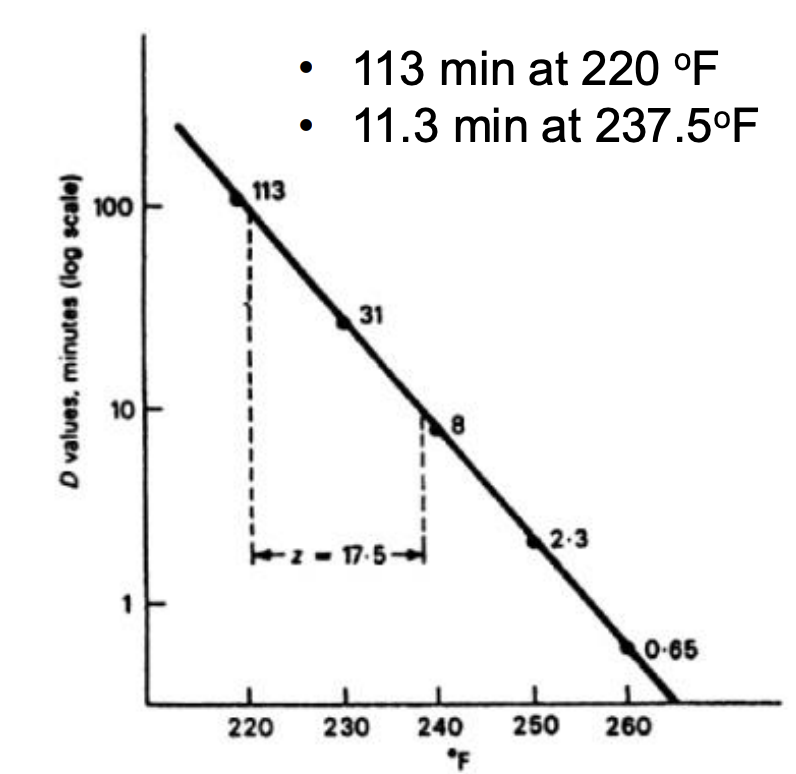
Determine z Value of the graph shown (z value at 10-fold)
How about from 10 → 1 ?
100 → 220 F = 113 mins (D)
10 → 237.5 F = 11.3 mins (D)
237.5 F - 220 F = 17.5 F = z value
10 → 1
10 = 237. 5 F
1 = 257 F
z = 19.5
_ is the time at given temp needed to kill spores or vegetative cells of particular organism
F value
_ is a process lethality requirement
Minimum heat process should reduce probability of survival of most resistant C. botulinum endospores to 10-12
Applied in canning industry (food > pH 4.6)
C. botulinum endospores do not germinate & produce toxins below pH 4.6
12-D concept
_ is a traditional fpm that lowers moisture content to a point where activities of foodborne microorganisms are inhibited
Endospores, bacteria, many fungi survive this
Effects on spoilage
Aw = 0.80 and 0.85 → Fungal spoilage in 1–2 weeks
Aw = 0.75 → Delay > 2 weeks
Aw = 0.65 → ~2 years delay; Very few spoilage organisms
Drying
Enumerate 4 novel techniques in food preservation
phpp
Pulsed Electric Fields
High-Pressure Processing
Pulsed Light Technology
Plasma Technology
Novel technique
Nonthermal method of microbial inactivation
Short time high-intensity sthi electric pulses between two electrodes placed in a food
Damages the cell membrane
Pulsed electric fields pef
Also known as high hydrostatic pressure (HHP)
Nonthermal method of microbial inactivation
Short duration pressurization sdp of a packaged food in a water-filled, closed chamber
Changes in microbial protein structures and other macromolecules
High-pressure processing
Nonthermal method of microbial inactivation
Short duration high-energy sdhe light pulses (170–2600 nm)
Acts on nucleic acids, proteins, membranes, and other cellular components
Pulsed light technology
Low-temperature plasma – Gas mixture of nitrogen, oxygen, and carbon dioxide
Highly toxic free-radicals and ionic species fris
Plasma technology
T/F: Novel techniques in food preservation are generally better for preserving heat-sensitive food
TRUE
Fundamental principles, procedures, means priprome needed to design environment suitable for quality food production
Developed by governments, Committee on Food Hygiene (e.g. WHO), and the food industry
Good Manufacturing Practice (GMP) / Current Good Manufacturing Practice (bc they change over time, is updated over time)
_ is a key factor for industries to produce good quality, safe, affordable products
cGMP
Give 3 examples of general GMP guidelines
ats
There should be an adequate number of personnel, as determined by the company, at all levels with knowledge, skills, and capabilities relevant to their assigned functions, in good mental & physical health to be able to execute their duties
All employees directly engaged in manufacturing activities shall be trained in the particular operations they perform in accordance with the principles of GMP
Plants, buildings, & structures shall be of suitable size, design, & construction to facilitate maintenance & sanitary operations for food manufacturing purposes
Individual working areas shall be adequate so that any risk of confusion & cross-contamination that will affect the safety of the food manufactured will be avoided
*GMP varies across countries
A tool to assess hazards and establish control systems
To ensure food safety
Hazard Analysis Critical Control Point (HACCP)
Enumerate 7 HACCP principles
h4c vr
Hazard analysis
Critical control points (CCPs)
Critical limits
CCP monitoring
Corrective actions
Verification
Record keeping
HACCP principle
Preparing a list of steps in the process where significant
hazards occur
Describing the preventative measures
Which hazards can be eliminated or reduced to acceptable levels?
Hazard analysis (HA)
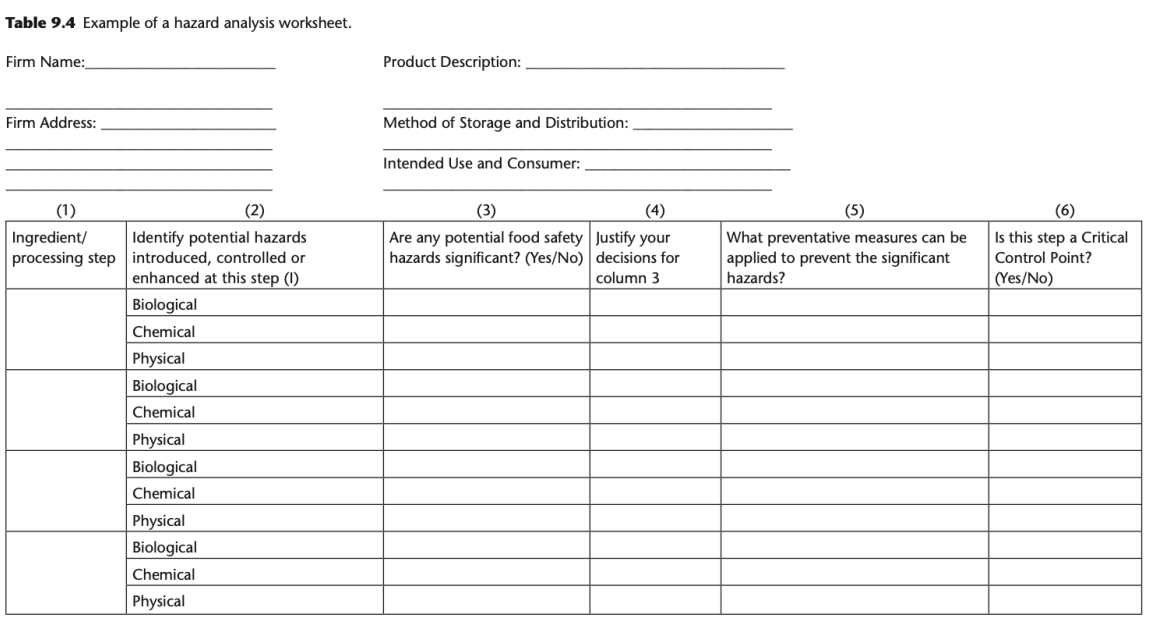
HACCP principle
Essential for the elimination or acceptable reduction of
the hazards
Must be a quantifiable procedure
Identified using decision trees
Critical control points
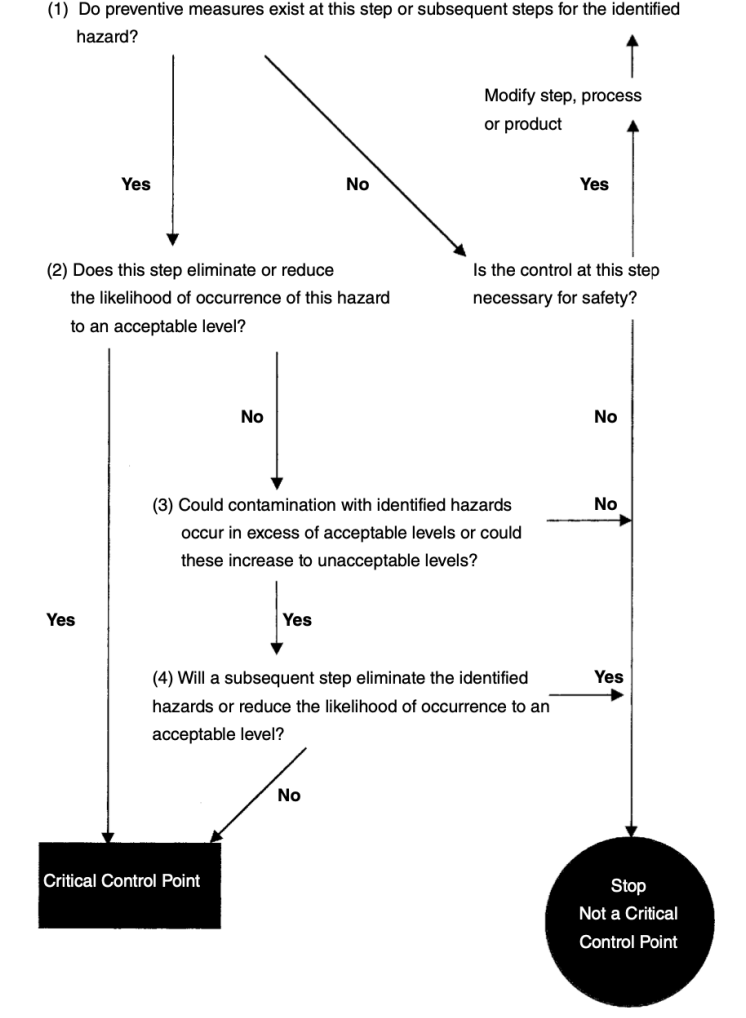
HACCP principle
Describe the difference between safe and unsafe
products at the CCP
A quantifiable PARAMETER
e.g. temperature, time, pH, moisture, aw, salt
concentration, titratable acidity, available chlorine ttpma sta
Critical limits
HACCP principle
Establishing mpam
Monitoring requirements
Procedures to adjust the process
Procedures to maintain control
CCP Monitoring
HACCP principle
To be taken when monitoring indicates a deviation from
an established Critical Limit
Must be developed for each CCP
Corrective actions
HACCP principle
Establish procedures for verification that the HACCP
system is working correctly
Conducted routinely or on an unannounced basis
Verification
HACCP principle
Establish effective record‐keeping procedures that document the HACCP System
To demonstrate sa
Safe product manufacture
Appropriate action has been taken for any deviations from the Critical Limits
Record Keeping
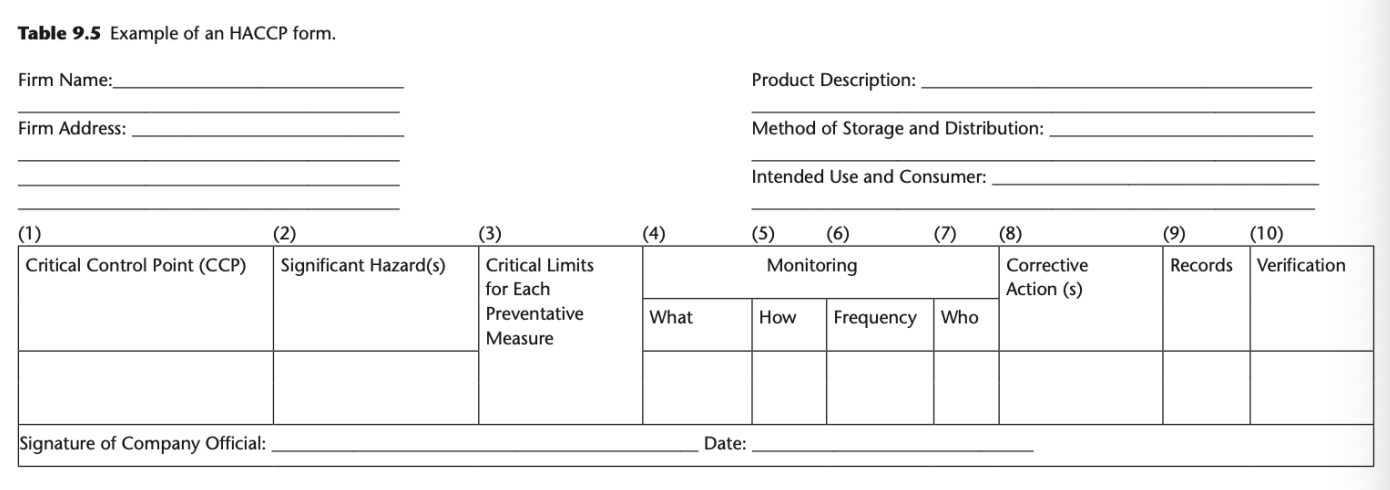
_ is the effort to protect food from acts of intentional adulteration, tampering, or contamination atc
Food defense
Explain deliberate food alterations & their consequences
Food alterations pibf
Production or distribution points
Individual food items or bulk foods
Biocrime – Disgruntled individual/employee
Food terrorism – Terrorist groups
Consequences pepl
Public health burden
Economic loss
Public fear
Loss of confidence in political and regulatory authorities
_ are same pathogens that cause outbreaks of foodborne illness due to accidental contamination
Biocrime organisms
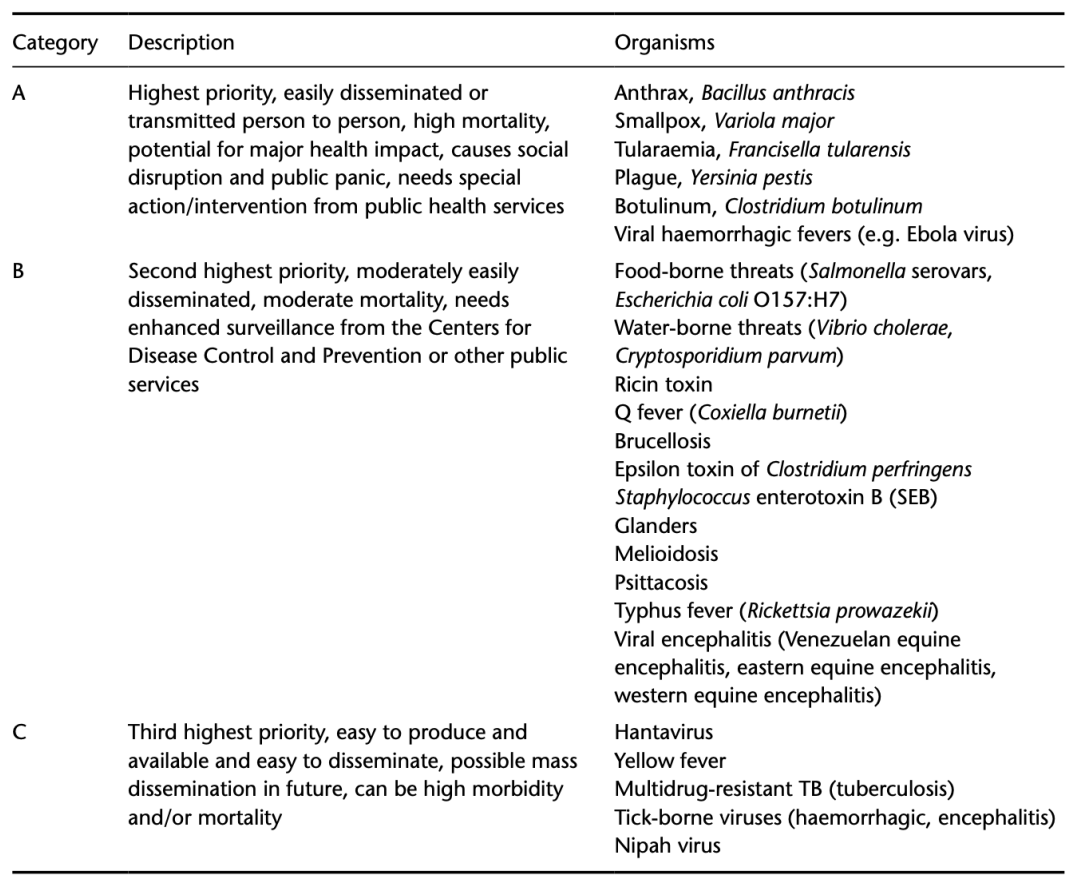
Give 3 examples of biocrime cases
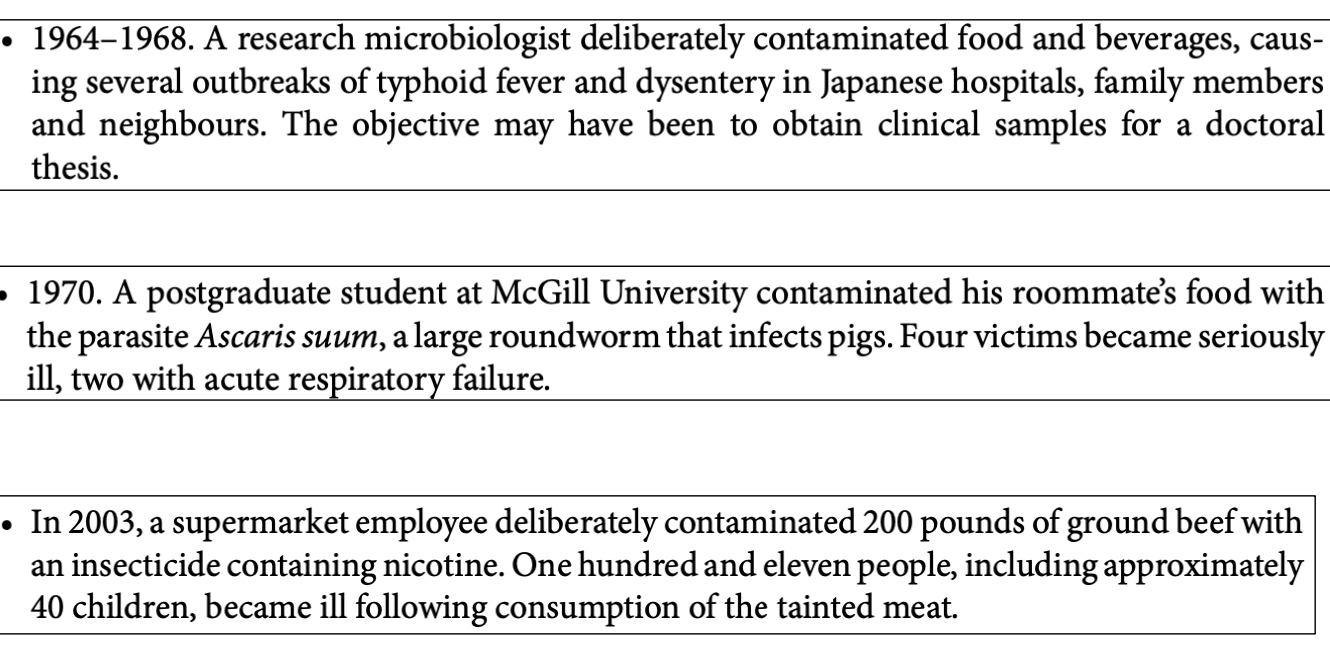
Stepwise analysis of hazards that may be associated with a particular type of food product
Estimates the probability of adverse effects on health from consuming the product in question
Microbiological risk assessment (MRA)
_ is a function of the (L) probability of an adverse health effect and the (C) severity of that effect
f (L,C)
Higher likelihood + higher consequence → greater risk
Consequence has more weight relative to likelihood
e.g., low likelihood + high consequence → not necessarily low
Risk
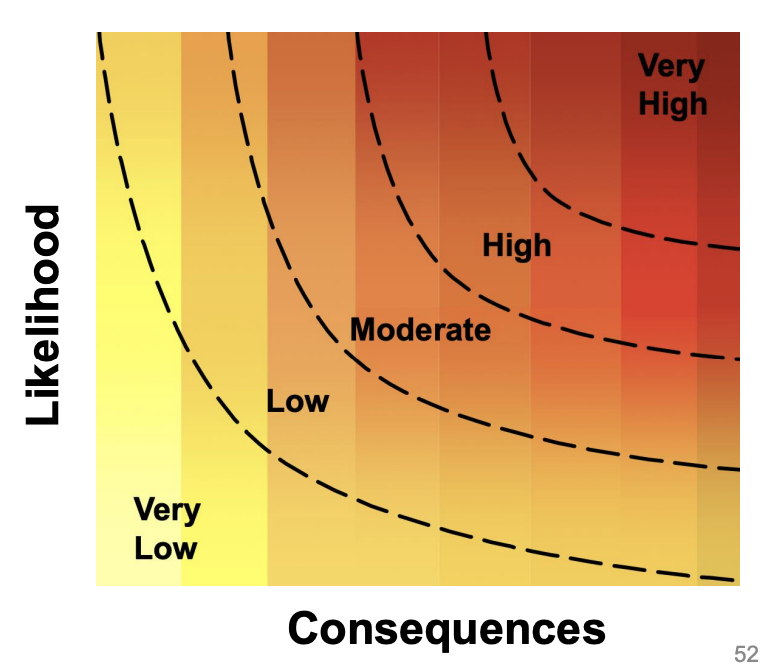
Describe general framework of MRA
